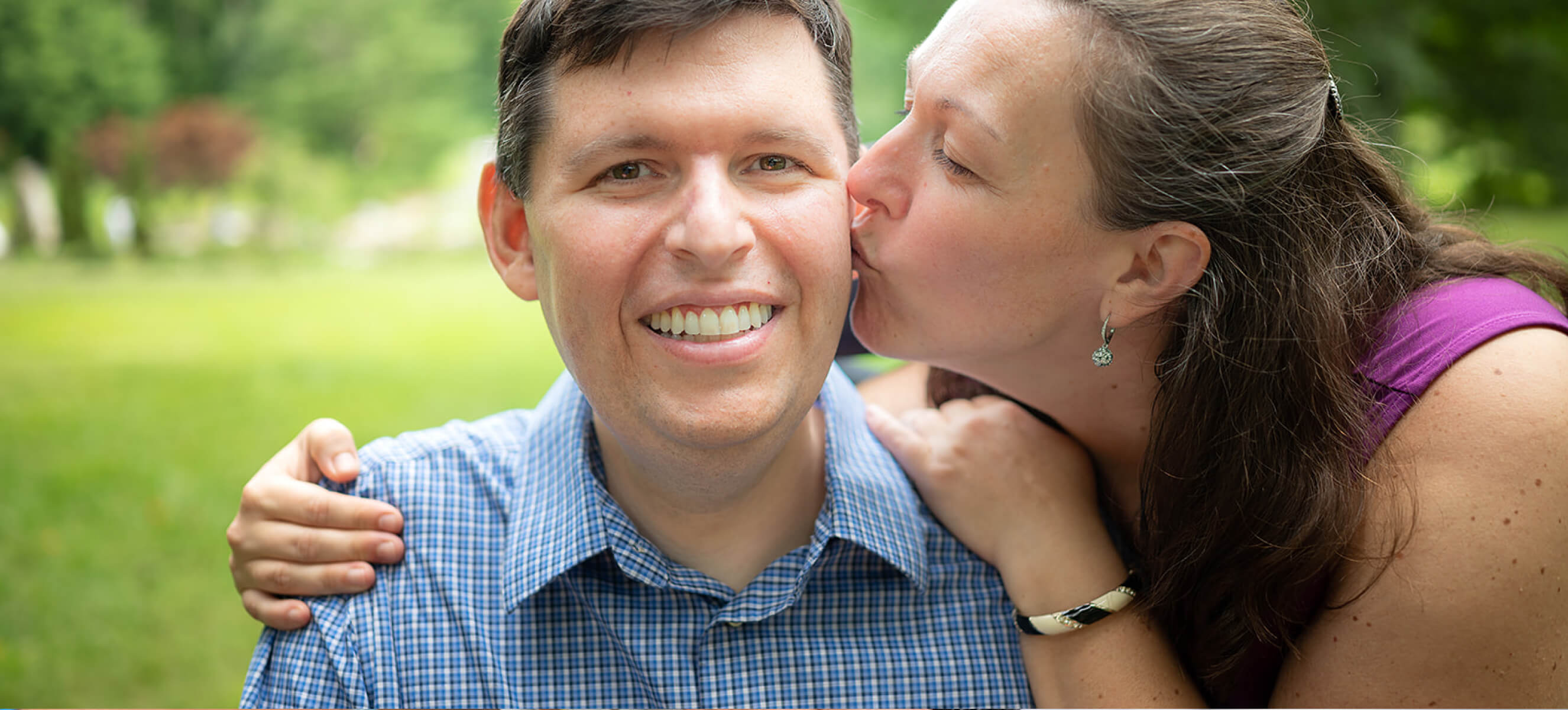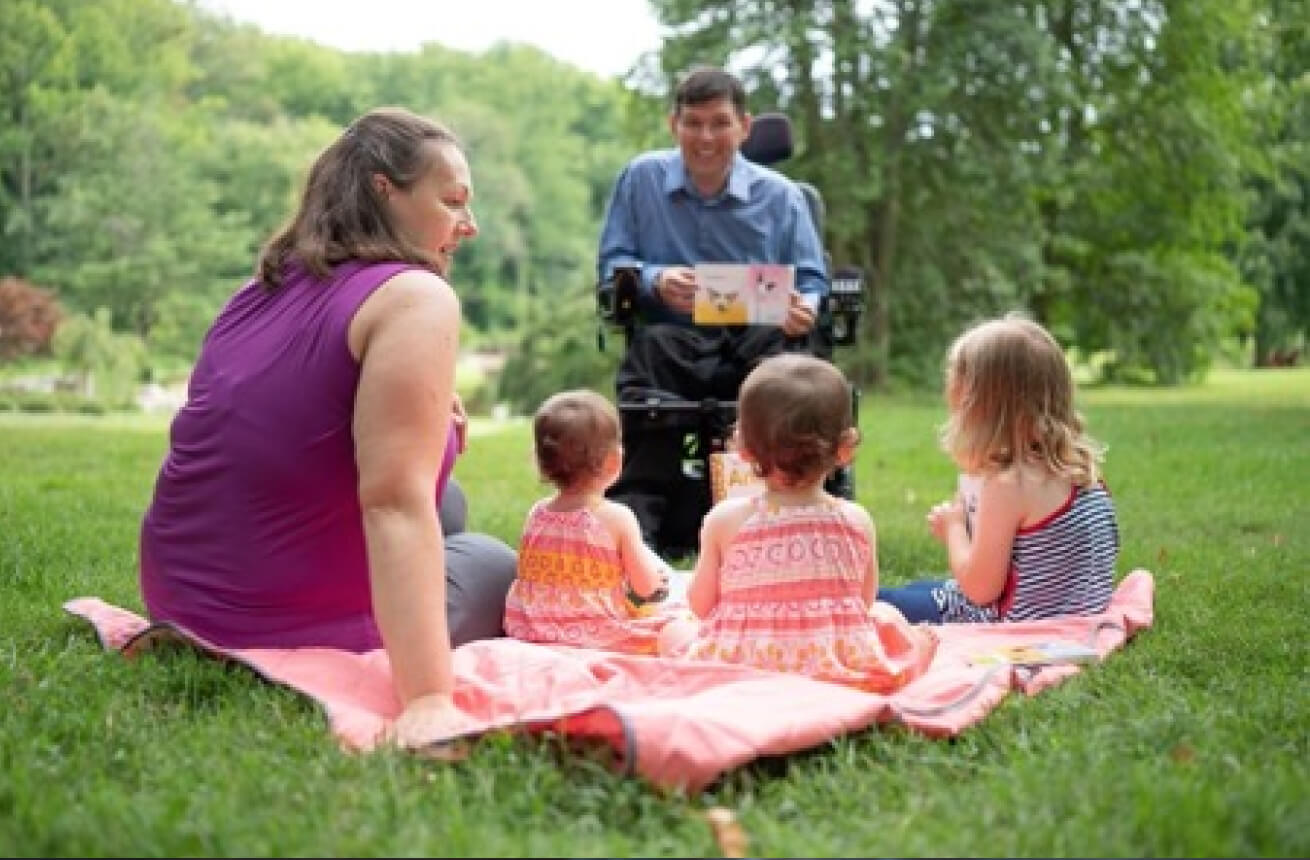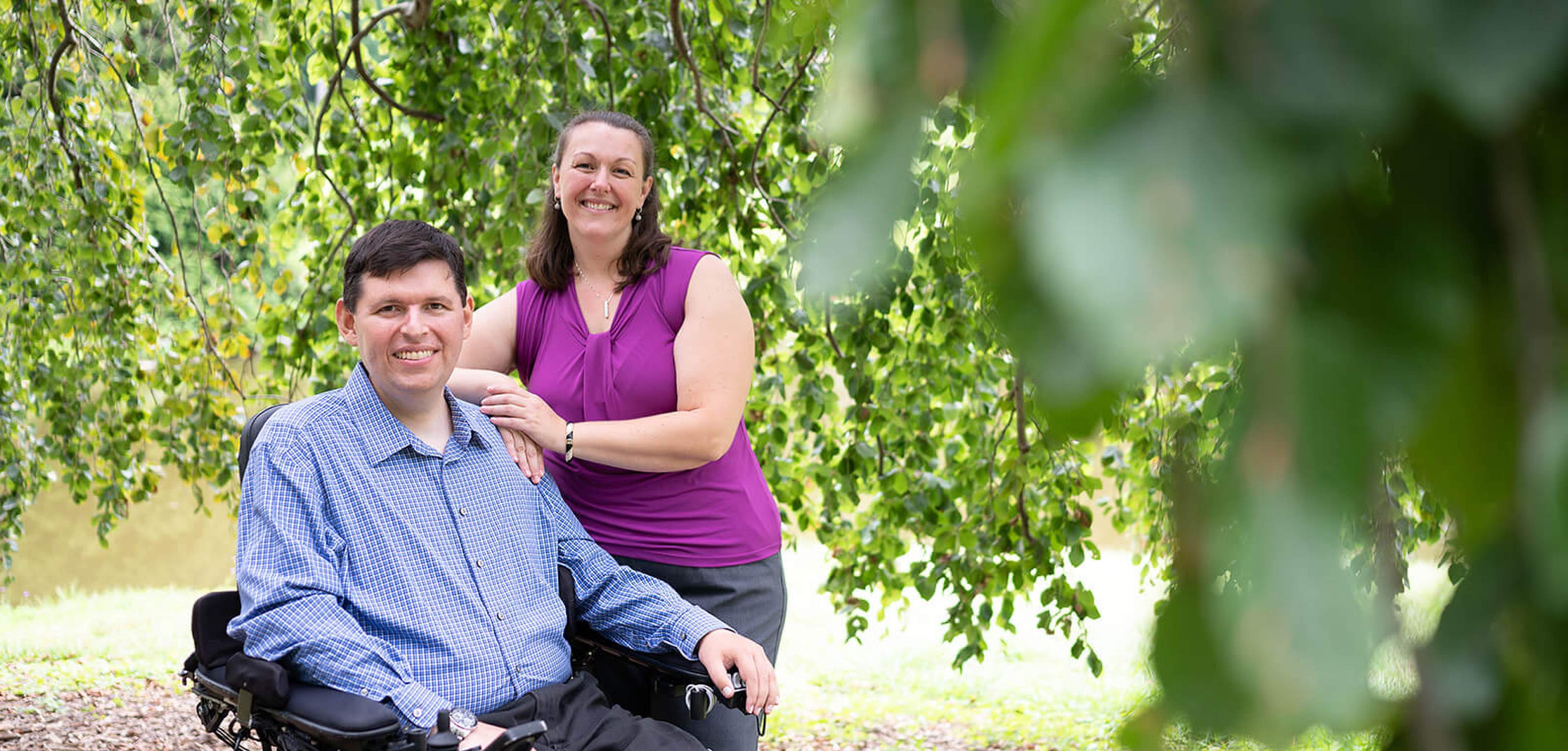Stories of Becker
Mario
Living with Becker Muscular Dystrophy
Silver Spring, MD | Born September 1977
Over the past 50 years, there has been a lot of progress on disability rights, but there is still a long way to go. My hope is that this trajectory will continue, and there will be more and better opportunities for—and greater inclusion of—people with disabilities in the years ahead.

Mario sat at the end of the long table at the hibachi restaurant tapping his fingers nervously against the hardwood table, unsure of who to make eye contact with. It was his first singles event, hosted by a DC-area young-professionals networking organization, and the up-and-coming lawyer rode out his anxiety as coolly as possible. He pretended not to notice when, at the other end of the table, a young woman lifted her chair to relocate. She walked toward him, chair in hand.
“Hello,” she greeted him amicably.
“Hi,” Mario responded, turning toward her.
“Oh, sorry.” she said. “Is there enough room? I didn’t see your wheelchair.”
Mario remained calm. “No. No. Don’t worry,” he implored. “I’ll gladly move over for you.” He smiled and hoped for the best, but there was no issue. She smiled back. He quickly repositioned his chair and she placed her chair next to his.
Theresa had never gotten close to someone who used a wheelchair before, but that night it became clear that Mario was someone worth knowing. He was worldly, intelligent, charming, interesting—he asked about her passions (and work as a geophysicist) as much as he could talk about his own. “I had never gotten to know someone with a significant disability,” she says, reflecting on the initial meeting with her now husband. “I didn’t have the right language to talk about it then.”

“She was instantly accepting of my disability,” remembers Mario, speaking from the home the two now share in Silver Spring, MD. “It became clear early on what my limitations were. She’s had no problem adapting to my changing needs over the last several years.” Mario and Theresa’s love steadily grew from their first chance meeting and quickly blossomed into a steady relationship, a marriage, and now, a young family with three daughters: Petra, the oldest, and identical twin infants, Ginevra (“Ginny”) and Evelina (“Evie”).
Mario’s family and career arose from what once was a cloud of doubt due to a diagnosis that could have defined his existence. He lives with Becker muscular dystrophy (BMD), a rare neuromuscular disorder that progressively weakens his muscles on the cellular level. As Mario ages, his muscle strength will continue to diminish, but this circumstance only fuels his voracious drive to improve the world for people like him. For the past 15 years, Mario has worked for the federal government in the disability rights arena and has influenced national policy, supporting people with disabilities in their long quest for better accessibility in the United States. “Disability does not slow this man down,” says Theresa, laughing. “He does what he wants to do. If it’s not obvious how to do something, he finds a way. He’s really positive about life.”
Mario’s upbringing in many ways defined the limitlessness of possibilities. His father, Bruno, emigrated from Italy after World War II, and married Judy, an Italian-American from Ohio. His parents were socialites, who loved to host large gatherings at their house with diverse company. Bruno worked as a college professor who lectured internationally while Judy ran a travel agency. This meant that from a young age Mario began traveling the world, visiting nearly 40 countries.
However, not all destinations were far away. For holidays, Mario would sometimes visit his mother’s family in Ohio. There he would get to see his cousin, Chuck, who was born with Duchenne muscular dystrophy (DMD). Chuck was older but early on exhibited some of the fears as well as the resolve that would come to define Mario. “Chuck had a positive attitude and good sense of humor,” he remembers. “He didn’t complain about his condition. Instead, he tried to live his life to the fullest. He was certainly an example for me.”
At three years old, Mario started exhibiting symptoms that would clue his parents that he might be affected by a similar disorder. Though he walked fine, he grew enlarged calf muscles and stood up from the ground in a peculiar fashion, using his hands on his legs to upright himself. This technique, known as Gowers’ sign, caught his parents’ attention, and they brought him to a neurologist to be evaluated. Suspecting Mario might have some form of muscular dystrophy, the neurologist recommended a muscle biopsy.
Mario was initially misdiagnosed with Duchenne. The news was delivered with little sympathy—doctors offered little information or hope. “The doctor just said, ‘Your son has Duchenne. He’s probably not going to live past his teens,’” Mario retells. Once the initial shock wore off, Bruno and Judy took it upon themselves to come to terms with and educate themselves about the condition. Judy promptly connected with the local chapter of the Muscular Dystrophy Association (MDA), where she soon began to advocate, volunteer at the MDA clinic at Children’s National Medical Center, organize local fundraising events, and create various opportunities for Mario. He was featured three times on a local broadcast of the MDA telethon, helping to fundraise for a cure to his disease, and developed close relationships with members of the Montgomery County Fire Department for the annual Fill the Boot campaign to support the MDA.
Paramount to his condition, Mario was included in all activities possible—at home, on the road, or in school. “I wasn’t treated differently by those closest to me, especially my parents and family members,” recalls Mario. “That’s the philosophy I’ve taken: Do the best with what you have. That’s something that people with disabilities realize more than the general population.”
One thing that his parents did not want to chance was birthing another child with the incurable disease. They decided to adopt a girl from Costa Rica, two years younger than Mario. “I was overjoyed,” he remembers. Maria Gabriela (“Gabi” to Mario) has been one of his fiercest allies over the years and was able to help him considerably as his mobility declined in his teenage years. “I used to have a bedroom on the second floor,” recalls Mario. “If I was too tired to climb the stairs, she would give me a piggy-back ride up.”
As Mario grew, it became obvious that his trajectory would be different from his cousin’s. Chuck lost the ability to walk before his teen years and suffered a steady decline in physical abilities, requiring around-the-clock care. “My progression looked nothing like his,” says Mario. “I was walking until I was 23.” With advancements in genetic testing, doctors were able to determine what already seemed clear to some—that Mario had Becker and not Duchenne.
Meanwhile, Chuck’s health declined steadily into his early 20s until living itself became a struggle. “He had two final wishes,” remembers Mario. “Finishing college and talking to Jerry Lewis to thank him for supporting the MDA.” With hard work and determination Chuck was able to achieve both before he passed away from Duchenne at age 23. “His loss was felt heavily throughout my family,” reflects Mario, who’s had to come to terms with the questions of mortality interwoven into any MD diagnosis.
In a similar spirit to his cousin, Mario pursued lofty goals, and was fortunate to have the time to achieve them. He went to The Catholic University of America in DC to pursue his undergraduate studies. It was on campus that the lightbulb first went off: Even with the well-intentioned guidance of the school administration, there was not enough attention given to the needs of the disabled student population. And Mario needed more accommodations now that he was in college. As his condition progressed, he began to have increased difficulty walking, even short distances.
On a snowy morning, Mario pulled into the parking lot, attempting to get to class on time. However, all the accessible parking spaces were buried under a huge snowbank. “They put the snow there because they thought the space was underutilized,” says Mario. “That struck a nerve with me. I wrote a letter to the head of facilities to correct the problem.” After ameliorating that issue, Mario began to recognize and tackle more problems of accessibility at the school. “I started meeting others with disabilities on campus,” he recalls. “They had the same needs as I did, so we started teaming up to do advocacy together.”
In 1998, before even finishing his undergraduate degree, Mario started law school as part of a B.A./J.D. joint degree program that Catholic offered. “I first thought I was going to be a prosecutor,” he recalls. As his disease progressed, he was forced to reevaluate his plans. “For me, that lifestyle—working long hours at a firm or in court, and the physical toll it can take on you—was one that I didn’t think I could sustain, and led me to choose a different path. Thinking back, and seeing the success that people with disabilities are achieving in a variety of fields, I probably could have done it, but I have no regrets about the career path I've chosen.”
A different challenge was calling, and Mario became ensconced in the world of legal advocacy for people with disabilities. “I’ve learned a lot about the disability rights movement and what those before me did for the disability community,” he says with sincere appreciation. “Without them, there would be no Rehabilitation Act of 1973 or ADA [Americans with Disabilities Act], among other achievements. Their legacy is something we can never forget and must always try to honor.”
In 2006, his budding passion became his career, when he landed a job with the Office of Disability Employment Policy at the US Department of Labor, where he worked to increase the employment of individuals with disabilities in the public and private sectors nationwide.

His good record at the Labor Department opened more doors and opportunities to use his legal expertise to alleviate issues of discrimination in an able-bodied world. In 2014, a position at the US Access Board, a small federal agency, opened up and Mario was recruited. He still works there today, where his chief duty is the enforcement of the Architectural Barriers Act of 1968. The law requires US federal buildings and facilities, such as post offices, courthouses, and national parks to meet certain accessibility standards. Mario fields complaints from people who encounter accessibility barriers, and is pleased that his work produces real-world results.
“Over the course of the last 20 years, I have seen disability discrimination firsthand and learned about the varying needs that people with different kinds of disabilities have. In my work, I try to do my small part to defend their rights and reduce the stigma around having a disability.” Outside of work, Mario relishes his role as a mentor and resource for others with Becker or Duchenne. He sat on the Parent Project Muscular Dystrophy’s (PPMD) Adult Advisory Committee and currently advises pharmaceuticals conducting trials for treatments for Duchenne and Becker. Mario also holds a seat on the Montgomery County, MD, Commission for Persons with Disabilities, looking at access issues on the local level. As if that wasn’t enough, Mario also serves as a Community Member of the Intramural Institutional Review Board at the National Institutes of Health (NIH), where he reviews ongoing clinical studies on a variety of illnesses and diseases to ensure that the rights and safety of subjects are protected.
“Over the past 50 years, there has been a lot of progress on disability rights, but there is still a long way to go,” Mario reflects. “My hope is that this trajectory will continue, and there will be more and better opportunities for—and greater inclusion of—people with disabilities in the years ahead.”

In recent years, Mario’s take-the-world-by-storm attitude shifted somewhat when he and Theresa decided to start a family. However, as with many families living with rare genetic illnesses, the decision was not easy. “Because Becker is an X-linked recessive disease, we knew if we had boys, they would definitely not have the disease, and if we had girls, they would definitely be carriers,” says Mario. In an effort to select for boys, Mario and Theresa tried IVF with preimplantation genetic diagnosis (PGD), an expensive and difficult process, to no avail. They considered adoption, but in the end decided to proceed without medical intervention. “When you look at Mario, carriers like his mom and aunt, and his cousin Chuck—even though his life was shorter—they are all excellent, wonderful human beings,” says Theresa. “Does it make sense not to have a human being like that in the world just because they’ll be a carrier or might have a significant disability? Everyone has difficulties; this is just one that we already know about.”
Their decision was also bolstered by developments in medicine that will potentially improve the outcomes for people with Becker in the future. “By the time my daughters are of child-bearing age, the hope is that medical advancements will be such that there will be a cure for Duchenne and Becker, or that they can be easily treated,” says Mario. “We thought, with a couple decades, it would be something that would be easier for them and their offspring.”
Petra, Mario’s eldest daughter, jumps rambunctiously on the side of her father’s wheelchair, and begs for a ride around the block—one of her favorite activities with daddy. Mario laughs and closes his laptop. He and Theresa both work mainly from home these days, largely due to the pandemic, yet the late afternoon sun beckons them to get outside. Theresa packs a series of food containers with sandwiches and salads for a picnic.
The family heads out into the humid evening air to their favorite local park. Petra jumps with joy into Mario’s lap and rides along with him on his chair as he wheels her down the paved paths toward a peaceful spot under a tree. Theresa parks the twins in their double-sized stroller and the family settles down for a quiet meal surrounded by gardens and nature. Mario pulls up his chair to the picnic blanket. The twins, now awake, come crawling toward their father, surrounding him with giggles and hugs. They eat and then Mario takes out a picture book and reads them a story. For Mario, these are the relaxing moments that make his life’s work worth it.
Telling his own story has caused him to reflect on some of what makes it special. “Harkening back to that room in a hospital in 1980, when my mom was given the news: If you asked her back then, will Mario live to be an adult, live old enough to marry and have kids, the answer would be no way. Yet here we are. Married, homeowners with kids. I’m very fortunate that my life has played out the way it has.”
[1] At the time of Mario’s diagnosis, in 1980, the dystrophin gene had not yet been mapped out, but a more advanced understanding of the genetics of multiple muscular dystrophies was on the horizon. The dystrophin gene was first identified in 1986 and by the early 90s, doctors could accurately determine, via a biomarker, if a child had Duchenne or Becker while they were still young.

